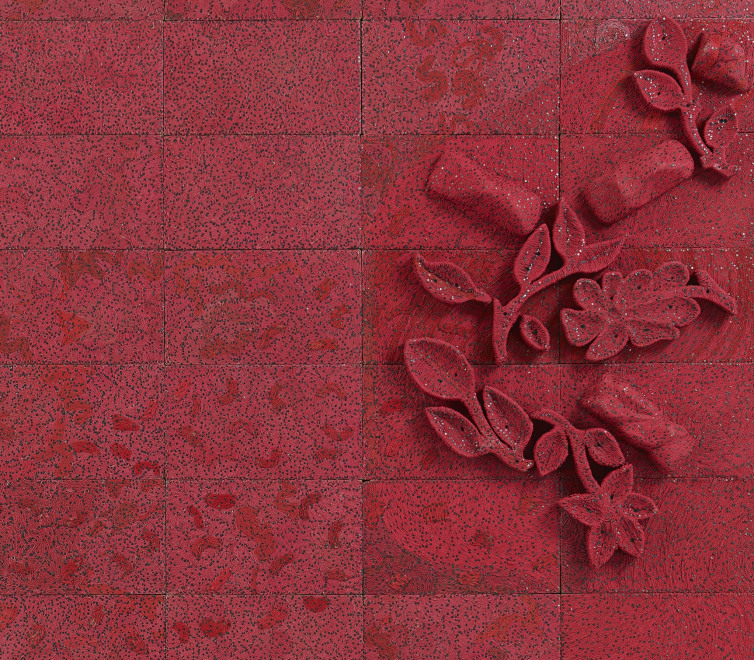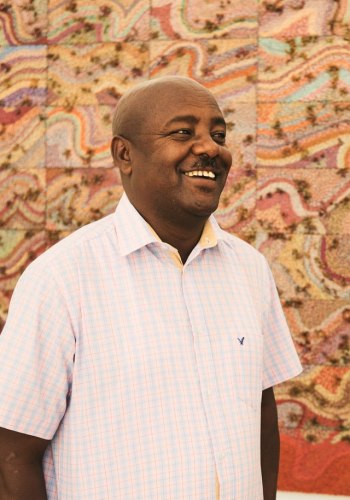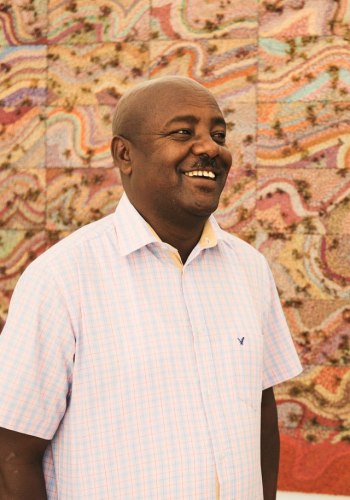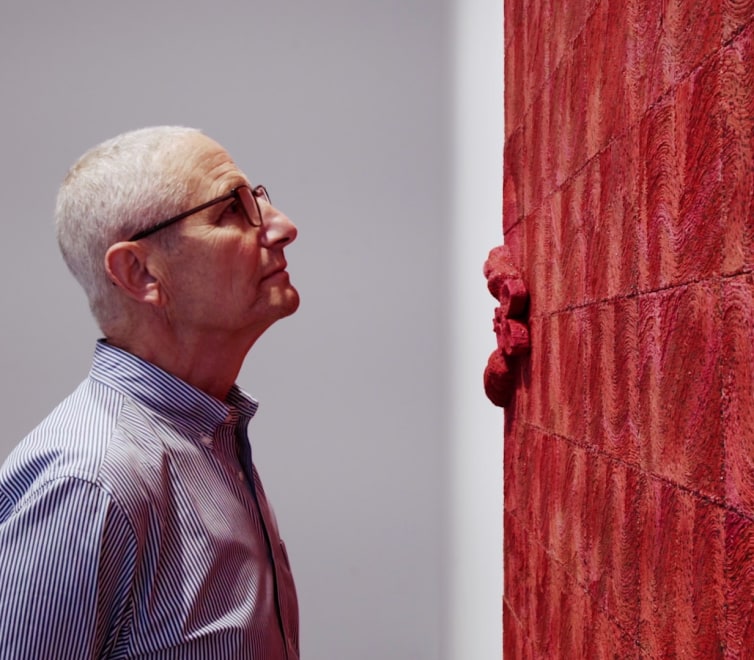
ELIAS SIME
Tightrope: It is Green 4, 2023
Electrical wires on panels
82 x 79 x 3 in.
208.3 x 200.7 x 7.6 cm
JCG15248
ELIAS SIME
Tightrope: It is Green 6, 2023
Electrical wires on panels
82 x 94 x 4 in
208.3 x 238.8 x 10.2 cm
JCG15250
ELIAS SIME
Tightrope: It is Green 8, 2023
Electrical wires on panels
99 x 125 1/2 x 3 1/2 in
251.5 x 318.8 x 8.9 cm
JCG15252
ELIAS SIME
Tightrope, 2022
Reclaimed electrical wires and components on panel
72 3/4 x 45 in.
184.8 x 114.3 cm
JCG13705
Installation view, Elias Sime, Venice Biennale, The Milk of Dreams, Venice, Italy, April 23 - November 27, 2022.
Installation view, Elias Sime, Venice Biennale, The Milk of Dreams, Venice, Italy, April 23 - November 27, 2022.
Installation view, Elias Sime, Venice Biennale, The Milk of Dreams, Venice, Italy, April 23 - November 27, 2022.
Installation view, Elias Sime, Venice Biennale, The Milk of Dreams, Venice, Italy, April 23 - November 27, 2022.
Installation view, Elias Sime, Venice Biennale, The Milk of Dreams, Venice, Italy, April 23 - November 27, 2022.
Installation view, Elias Sime, Venice Biennale, The Milk of Dreams, Venice, Italy, April 23 - November 27, 2022.
Installation view, Elias Sime, Venice Biennale, The Milk of Dreams, Venice, Italy, April 23 - November 27, 2022.
ELIAS SIME
Red Leaves, 2021
Three-dimensional wall piece with woven electrical wires and other components on wood panels
81 x 237 x 7 in.
205.7 x 602 x 17.8 cm
JCG13270
ELIAS SIME
Veiled Whispers, 2021
Three-dimensional wall piece with woven electrical wires and other components on wood panels
79 x 225 x 8 in.
200.7 x 571.5 x 20.3 cm
JCG13447
ELIAS SIME
Tightrope, 2022
Reclaimed electrical wires and components on panel
92 x 95 x 1 in.
233.7 x 241.3 x 2.5 cm
JCG13710
ELIAS SIME
Tightrope, 2022
Reclaimed electrical wires and components on panel
64 x 48 in.
162.6 x 121.9 cm
JCG13706
ELIAS SIME
Tightrope: Desire, 2021
Reclaimed electrical wires on panel
99 x 96 in.
251.5 x 243.8 cm
JCG12814
ELIAS SIME
TIGHTROPE: ECHO!?, 2021
Reclaimed electrical components on panel with two megaphones
54 x 48 in.
137.2 x 121.9 cm
JCG12727
ELIAS SIME
TIGHTROPE: ECHO!?, 2021
Detail
ELIAS SIME
TIGHTROPE: ECHO!?, 2021
Reclaimed electrical wires and components on panel with three megaphones
70 x 74 x 12 in.
177.8 x 188 x 30.5 cm
JCG12117
ELIAS SIME
TIGHTROPE: ECHO!?, 2020
Reclaimed electrical wires and components on panel
105 x 83 1/2 x 9 in.
266.7 x 212.1 x 22.9 cm
JCG11882
ELIAS SIME
TIGHTROPE: ECHO!?, 2020
Detail
ELIAS SIME
Tightrope: Noiseless 16, 2019
Reclaimed electrical wires and components on panel
100 x 77 in.
254 x 195.6 cm
JCG10841
ELIAS SIME
Tightrope: Noiseless 16, 2019
Detail
ELIAS SIME
Tightrope: Noiseless 12, 2019
Des Moines Art Center
Reclaimed electrical wires and components on panel
117 x 63 1/2 in.
297.2 x 161.3 cm
JCG10468
ELIAS SIME
Tightrope: Noiseless 18, 2019
Reclaimed electrical wires and components on panel
100 1/4 x 63 1/4 in.
254.6 x 160.7 cm
JCG10418
ELIAS SIME
Tightrope: Noiseless 18, 2019
Detail
ELIAS SIME
Tightrope: Noiseless 1, 2019
Reclaimed electrical wires and components on panel
112 5/8 x 173 1/4 in.
286 x 440 cm
JCG10412
ELIAS SIME
Tightrope: Noiseless 1, 2019
Detail
ELIAS SIME
TIGHTROPE: (26) While Observing..., 2018
Reclaimed electrical wires on panel
64 1/2 x 47 1/8 in.
163.8 x 119.7 cm
JCG9804
ELIAS SIME
TIGHTROPE: (26) While Observing..., 2018
Detail
ELIAS SIME
Tightrope: Narcissism, 2017
Reclaimed electrical wires on panel
64 x 95 in.
162.6 x 241.3 cm
JCG9022
ELIAS SIME
Tightrope 9, 2009-2014
Reclaimed electronic components on panel
63 x 236 1/2 in.
160 x 600.7 cm
JCG7839
ELIAS SIME
Tightrope 9, 2009-2014
Detail
ELIAS SIME
Tightrope 8, 2009-14
Reclaimed electronic components on panel
43 1/4 x 71 in.
109.9 x 180.3 cm
JCG7838
ELIAS SIME
Tightrope 5.1, 2009-14
Reclaimed electrical wires on panel
130 1/4 x 93 1/4 in.
330.8 x 236.8 cm
JCG7835
ELIAS SIME
Tightrope 5.1, 2009- 2014
Detail
ELIAS SIME
Tightrope 3, 2009-2014
Reclaimed electronic components and fiberglass on panel
69 x 192 in.
175.26 x 487.68 cm
JCG7833
ELIAS SIME
Tightrope, 2021
Woven electrical wires and other components on panel
47 1/2 x 48 in.
120.7 x 121.9 cm
JCG13155
ELIAS SIME
Tightrope, 2021
ELIAS SIME
TIGHTROPE: ECHO!?, 2020
Reclaimed electrical wire and components
144 x 126 x 1 1/4 in.
365.8 x 320 x 3.2 cm
JCG12020
ELIAS SIME
TIGHTROPE: ECHO!?, 2020
Detail
Installation view, Portals, NEON, Athens, Greece, June 6 - December 31, 2021
ELIAS SIME
Tightrope, 2021
Woven electrical wires and other components on panel
75 x 174 in.
190.5 x 442 cm
JCG13156
ELIAS SIME
TIGHTROPE: ECHO!?, 2021
Reclaimed electrical components on panel with two megaphones
54 x 48 x 9 in.
137.2 x 121.9 x 22.9 cm
JCG12725
ELIAS SIME
TIGHTROPE: (30) While Observing..., 2018
Reclaimed electrical wires and components on panel
95 1/4 x 63 in.
242 x 160 cm
JCG9794
ELIAS SIME
TIGHTROPE: (30) While Observing..., 2018
Detail
ELIAS SIME
Tightrope, 2021
Woven electrical wires and other components on panel
47 1/2 x 47 1/2 x 4 in.
120.7 x 120.7 x 10.2 cm
JCG13157
ELIAS SIME
Tightrope, 2021
Detail
ELIAS SIME
Tightrope, 2021
ELIAS SIME
TIGHTROPE: ECHO!?, 2021
Reclaimed electrical wires and components on panel with two megaphones
45 1/4 x 47 1/4 x 11 1/2 in.
114.9 x 120 x 29.2 cm
JCG12119
ELIAS SIME
Tightrope, 2021
Woven electrical wires and other components on panel
82 x 189 1/2 in.
208.3 x 481.3 cm
JCG13154
ELIAS SIME
Tightrope, 2021
Detail
ELIAS SIME
TIGHTROPE: ECHO!?, 2021
Reclaimed electrical components on panel with one megaphone
42 x 59 x 9 in.
106.7 x 149.9 x 22.9 cm
JCG12723
ELIAS SIME
TIGHTROPE: ECHO!?, 2021
Reclaimed electrical components on panel with two megaphones
45 1/4 x 47 1/4 x 16 in.
114.9 x 120 x 40.6 cm
JCG12116
ELIAS SIME
TIGHTROPE: ECHO!?, 2021
Detail
ELIAS SIME
TIGHTROPE: ECHO!?, 2020
Reclaimed electrical wires and components on panel
45 x 48 x 12 1/4 in.
114.3 x 121.9 x 31.1 cm
JCG11879
ELIAS SIME
TIGHTROPE: ECHO!?, 2020
Detail
ELIAS SIME
TIGHTROPE: ECHO!?, 2020
Reclaimed electrical wires and components on panel
55 7/8 x 80 1/4 x 10 1/2 in.
141.9 x 203.8 x 26.7 cm
JCG11881
ELIAS SIME
TIGHTROPE: ECHO!?, 2020
Detail
ELIAS SIME
Tightrope: From The Belly of The Earth 1, 2020
Reclaimed electrical wires on panel
126 x 173 1/2 in.
320 x 440.7 cm
JCG11366
ELIAS SIME
Tightrope: From The Belly of The Earth 1, 2020
Detail
ELIAS SIME
We Are All Green #7, 2019
Electrical wires and motherboard on carved wood
40 3/4 x 41 3/4 in.
103.5 x 106 cm
JCG11209
ELIAS SIME
Untitled, 2019
Reclaimed electrical wires and components on panel
48 x 42 in.
121.9 x 106.7 cm
JCG11143
ELIAS SIME
Tightrope: Noiseless 17, 2019
Reclaimed electrical wires and components on panel
63 x 112 in.
160 x 284.5 cm
JCG10842
ELIAS SIME
Tightrope: Noiseless 17, 2019
Detail
ELIAS SIME
Tightrope: Silent 2, 2019
Reclaimed electrical wires and components on panel
72 1/2 x 126 in.
184 x 320 cm
JCG10417
ELIAS SIME
Tightrope: Noiseless 10, 2019
Reclaimed electrical wires and components on panel
72 x 114 in.
182.9 x 289.6 cm
JCG10413
ELIAS SIME
Tightrope: Noiseless 10, 2019
Detail
ELIAS SIME
Tightrope: Noiseless 5, 2019
Reclaimed electrical wires and components on panel
72 1/2 x 142 1/2 in.
184.2 x 361.9 cm
JCG10463
ELIAS SIME
Tightrope: Noiseless 5, 2019
Detail
ELIAS SIME
Tightrope: Noiseless 2, 2019
Reclaimed electrical wires and components on panel
101 x 158 in.
256.5 x 401.3 cm
JCG10470
ELIAS SIME
Tightrope: Noiseless 2, 2019
Detail
ELIAS SIME
TIGHTROPE: (9) While Observing..., 2018
Reclaimed electrical wires and components on panel
95 x 62 in.
241.3 x 157.5 cm
JCG9784
ELIAS SIME
TIGHTROPE: (4) While Observing..., 2018
Reclaimed electrical wires and components on panel
63 x 54 5/8 in.
160.0 x 139.0 cm
JCG9795
ELIAS SIME
TIGHTROPE: (2) While Observing..., 2018
Reclaimed electrical wires and components on panel
54 3/8 x 47 3/8 in.
138.1 x 120.3 cm
JCG9802
ELIAS SIME
TIGHTROPE: (7) While Observing..., 2018
Reclaimed electrical wires and components on panel
72 3/8 x 63 in.
183.8 x 160 cm
JCG9793
ELIAS SIME
TIGHTROPE: (7) While Observing..., 2018
Detail
ELIAS SIME
TIGHTROPE: (29) While Observing..., 2018
Reclaimed electrical wires and components on panel
72 3/8 x 78 5/8 in.
183.8 x 199.7 cm
JCG9787
ELIAS SIME
Tightrope: Evolution 2, 2017
Reclaimed electrical wires on panel
91 x 94 in.
162.8 x 320 cm
JCG9023
ELIAS SIME
Tightrope: Behind the Beauty, 2017
Reclaimed electronic components on panels
91 1/4 x 127 1/4 in.
231.8 x 323.2 cm
JCG9192
ELIAS SIME
Tightrope: The Dominant, 2017
Reclaimed electronic components on panel
81 3/8 x 126 in.
207 x 320 cm
JCG9097
ELIAS SIME
Tightrope: Impulsive Juggernaut of Progress, 2017
Reclaimed electronic components on panel
64 1/2 x 63 1/2 in.
163.8 x 161.3 cm
JCG9120
ELIAS SIME
Tightrope, Familiar Yet Complex 6, 2016
Reclaimed electronic components on panel
55 1/4 x 79 1/2 in.
140.3 x 201.9 cm
JCG8807
ELIAS SIME
Tightrope, Familiar Yet Complex 1, 2016
Reclaimed electronic components on panel
46 x 79 1/2 in.
116.8 x 201.9 cm
JCG8804
ELIAS SIME
Tightrope, Familiar Yet Complex 2, 2016
Reclaimed electronic components on panel
83 x 87 1/2 in.
210.8 x 222.3 cm
JCG8805
ELIAS SIME
Tightrope, Familiar Yet Complex 2, 2016
Detail
ELIAS SIME
Tightrope 7, 2009- 2014
Reclaimed electronic components, mixed media and wire on panel
110 1/2 x 361 in.
280.7 x 216.9 cm
JCG7837
ELIAS SIME
Tightrope 7, 2009- 2014
Detail
ELIAS SIME
Tightrope Mobile, 2009- 2014
Reclaimed electronic wires on panel
108 x 128 in.
274.3 x 325.1 cm
ELIAS SIME
Tightrope Mobile, 2009- 2014
Detail
ELIAS SIME
Tightrope 6.A, 2009- 2014
Reclaimed electrical wires on panel
75 1/2 x 133 in.
191.8 x 337.8 cm
JCG8041
ELIAS SIME
Tightrope 6.A, 2009- 2014
Detail
ELIAS SIME
Ants & Ceramicists 10, 2009- 2014
Yarn stitch and found objects on canvas
61 x 33 x 2 in.
154.9 x 83.8 x 5.1 cm
JCG7852
ELIAS SIME
Ants & Ceramicists 10, 2009- 2014
Detail
ELIAS SIME
What is Love? 13, 2007
Yarn stitch on canvas
37 3/4 x 29 1/4 x 1 in.
95.9 x 74.3 x 2.5 cm
JCG7725
ELIAS SIME
What is Love? 13, 2007
Detail
Zoma Museum
Addis Ababa, Ethiopia
2019
Zoma Museum
Addis Ababa, Ethiopia
2019
Zoma Museum
Addis Ababa, Ethiopia
2019
Zoma Museum
Addis Ababa, Ethiopia
2019
Zoma Museum
Addis Ababa, Ethiopia
2019
Zoma Museum
Addis Ababa, Ethiopia
2019

Elias Sime (b.1968 Addis Ababa, Ethiopia) deftly weaves, layers and assembles carefully selected everyday materials, transforming commonplace items into lyrical abstract compositions that suggest topography, figuration, and color fields. He often creates intricate works from electronic components—including circuit boards, computer keys, and telecommunications wires. For Sime, the history of these materials hold meaning and their significance emerges after thorough consideration. They suggest the tenuousness of our interconnected world, alluding to the frictions between tradition and progress, human contact and social networks, nature and the man-made, and physical presence and the virtual.
Sime’s work achieves effects from dense narrative to austere modernist abstraction. He is as interested in a stripped motherboard from a mobile phone as he is an animal skull or worn-out button: the artist looks past the emotional weighting of new versus old, instead finding renewal everywhere, and taking greatest interest in the way that objects and ideas can connect in new ways.
Sime has a masterful handling of material, with fluency and pure formal instincts a hallmark of his practice. In the past decade he has sought to better understand the cultural and historic underpinnings of those instincts, traveling with the anthropologist Meskerem Assegued through rural villages in Ethiopia to research ancient rituals still in practice. Sime collects histories and vernacular techniques as much as objects.
Holland Cotter of The New York Times writes, “Sime’s work, while culturally specific, has always been universalist. And although never without critical thrust — no one knows better the horrors visited on Africa by shipments of toxic Western e-waste — it is utopian.”
As an extension of his art-making, Sime is involved in the exploration of vernacular architecture. Working with his longtime collaborator, Assegued, Sime co-founded, designed, and built the award-winning Zoma Museum in Addis Ababa, an environmentally conscious international art center described by The New York Times in 2009 as “a voluptuous dream, a swirl of ancient technique and ecstatic imagination.” Zoma Museum celebrated its grand opening in its new location in March 2019, with expanded facilities that include a gallery space, library, children’s center, edible garden, elementary school, art and vernacular school, amphitheater, cafe and museum shop.
Sime has exhibited extensively around the world. His work has been shown internationally at the 59th Venice Biennale which took place from April 23 to November 27, 2022; the Dak’Art Biennale of Contemporary African Art in Dakar, Senegal; the New Crowned Hope Festival in Vienna, Austria; and in the United States at the Metropolitan Museum of Art, New York; the Studio Museum in Harlem; and a survey exhibition that traveled from the Santa Monica Museum of Art, California, to the North Dakota Museum of Art. The Wellin Museum of Art at Hamilton College presented Elias Sime: Tightrope in the fall of 2019, marking the artist’s first major museum survey. Curated by Tracy L. Adler, the Wellin Museum’s Johnson-Pote Director, the exhibition highlights Sime’s work from the last decade, much of which comprises the series entitled Tightrope, alongside a selection of early works critical to the artist’s development. The exhibition traveled to the Akron Art Museum in Akron, Ohio, the Kemper Museum of Contemporary Art in Kansas City, Missouri, and the Royal Ontario Museum in Toronto, Canada in Spring 2021. Elias Sime: Tightrope is accompanied by the first monograph focusing on the work of Elias Sime, co-published by the Wellin Museum of Art and DelMonico Books • Prestel. Recently, Sime has been the subject of major solo exhibitions Currents 118: Elias Sime at the Saint Louis Art Museum, MO (2020) and Eregata እርጋታ at Arnolfini in Bristol, United Kingdom (2023), which was accompanied by a catalogue. Opening on April 17, Sime will be the subject of the solo exhibition Elias Sime: Dichotomy ፊት አና ጀርባ, an official Collateral Event of the 60th International Art Exhibition – La Biennale di Venezia, at Spazio Tana, Castello in Venice, organized by Kunstpalast Dusseldorf. The exhibition will be on view through November 23, 2024. In 2019, Sime received an African Art Award from the Smithsonian National Museum of African Art and was shortlisted for the Hugo Boss Prize 2020.
Elias Sime’s work is included in the permanent collections of the Arkansas Museum of Fine Arts, Little Rock, AR; Carl & Marilynn Thoma Art Foundation, Santa Fe, NM; Chrysler Museum of Art, Norfolk, VA; Detroit Institute of Arts, MI; Des Moines Art Center, Des Moines, IA; de Young Museum, San Francisco, CA; Hood Museum of Art, Dartmouth College, Hanover, NH; Israel Museum, Jerusalem, Israel; Johns Hopkins University Campus Collection, Baltimore, MD; Kemper Museum of Contemporary Art, Kansas City, MO; Metropolitan Museum of Art, NY; Newark Museum, Newark, NJ; North Carolina Museum of Art, Raleigh, NC; North Dakota Museum of Art, Grand Forks, ND; Norval Foundation, Cape Town, South Africa; Pérez Art Museum Miami, Miami, FL; Pizzuti Collection at the Columbus Museum of Art, Columbus, OH; Rollins Museum of Art, Rollins College, Orlando, FL; Royal Ontario Museum, Toronto, Canada; Ruth and Elmer Wellin Museum of Art, Hamilton College, Clinton, NY; Saint Louis Art Museum, St. Louis, MO; Samuel P. Harn Museum of Art, University of Florida, Gainesville, FL; Toledo Museum of Art, Toledo, OH; Utah Museum of Fine Arts, Salt Lake City, UT; Virginia Museum of Fine Arts, Richmond, VA; and the 21st Century Museum of Contemporary Art, Kanazawa, Japan.

Elias Sime (b.1968 Addis Ababa, Ethiopia) deftly weaves, layers and assembles carefully selected everyday materials, transforming commonplace items into lyrical abstract compositions that suggest topography, figuration, and color fields. He often creates intricate works from electronic components—including circuit boards, computer keys, and telecommunications wires. For Sime, the history of these materials hold meaning and their significance emerges after thorough consideration. They suggest the tenuousness of our interconnected world, alluding to the frictions between tradition and progress, human contact and social networks, nature and the man-made, and physical presence and the virtual.

Gallery Exhibition at 48 Walker Street

Watch James Cohan explore the genesis of Elias Sime's Tightrope series and the ways in which Sime's work expresses the tenuousness of our interconnected world, alluding to the frictions between tradition and progress, nature and the man-made, and physical presence and the virtual.
